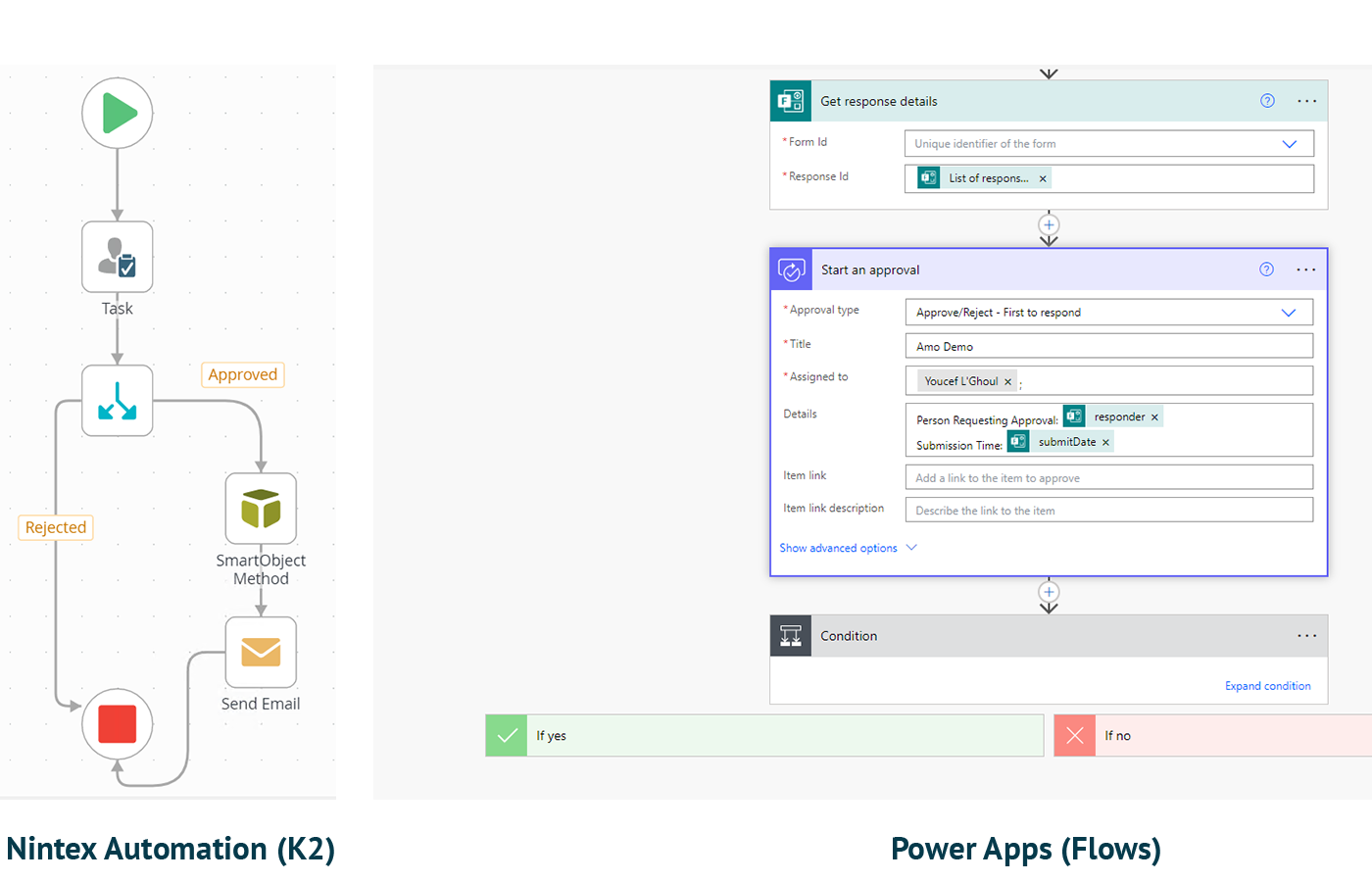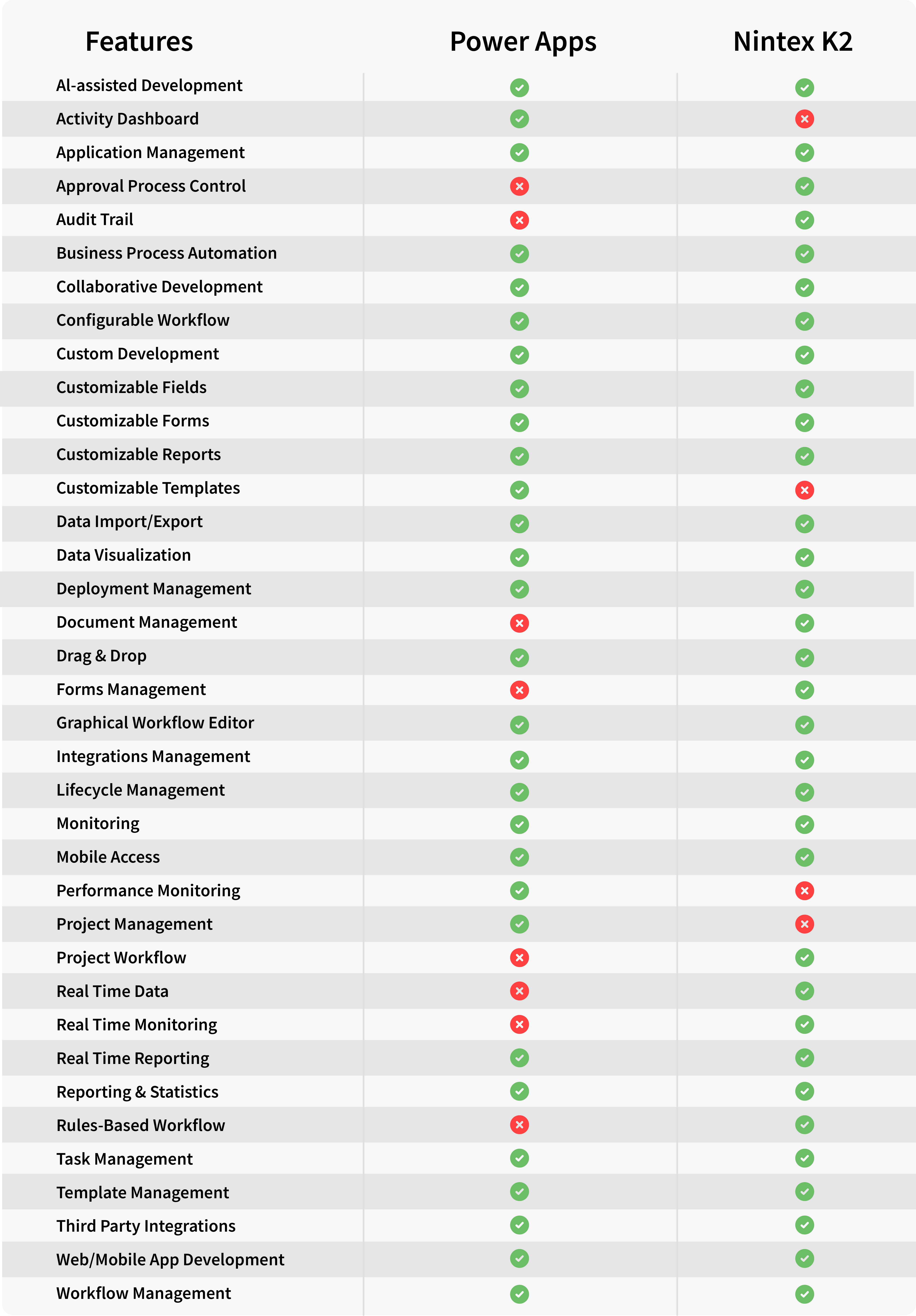
As per the predictions made by Gartner, the market for low-code development technology is estimated to reach a whopping $26.9 billion by 2023. It’s no surprise that more and more companies are adopting low-code development technologies to meet the ever-increasing demand for quick custom application delivery. Low-code platforms like Power Apps and Nintex K2 are becoming increasingly popular for building digital solutions.
But before you dive into using any of these platforms, it’s important to understand the differences between them. Both Power Apps and Nintex K2 have different features and functionalities that might make one more suitable for your needs than the other.
For instance, Nintex K2 allows easy integration with business data and several business solutions like CRMs, ERPs, and databases. On the other hand, Power Apps is a low-code/no-code tool that takes advantage of many features of Office 365 and the Microsoft platform, making it ideal for mobile devices or browser use.
Let’s deep dive into the differences between these two low-code platforms.
One significant advantage of Nintex K2 is that it can be deployed both on SaaS/Web/Cloud environments and on-premises (Windows Environment) – Nintex K2 Cloud and Nintex Automation (previously known as K2 Five). This flexibility allows customers to choose the product based on business policies and data governance.
Both platforms are designed for small/medium businesses but can also be used by large enterprises. But Nintex K2 can also be used to implement complex, process applications at an enterprise level.
Power Apps and Nintex K2 both offer a free trial period and use a subscription pricing model – Nintex K2 uses a quote-based pricing model.
When it comes to training and support, both platforms offer documentation, and in-person training and support are available online and during business hours. However, Nintex K2 also includes Live online and webinar training and provides live support 24/7.
The form design experience is quite different; Nintex K2 allows you to create a single form that can be run on a desktop or mobile device by selecting a responsive design. PowerApps, on the other hand, appears to be geared toward mobile devices, with phone and tablet options available when creating an app.

PowerApps uses the concept of “screens” which translates to Nintex K2 SmartForms, and for a simple app, you can find 3 screens – Browse, Details, and Edit. The browse screen is like a ListView in Nintex K2 and the Details and Edit screens are like an ItemView.
PowerApps does not have Rule Designer, and the formulas used in PowerApps are like what you would find in an Excel spreadsheet (VBA). VBA Knowledge is a must for PowerApps, while in Nintex K2 it is easy and quick to manage Events, and rules with the Rule Designer.
There are only two configuration options for the approval stage in Power Automate: “Approve” or “Decline.” It is challenging to set up a “rework” stage and reminders for the tasks, and there is no method to redirect the task if it is not completed within a certain amount of time.
Nintex K2 offers more flexibility when configuring any Action, as well as, a simple method to implement the rework stage by assigning the task to the INITIATOR. To top it all Nintex K2 also provides an easy-to-configure task reminder and escalation.
In K2 Workflow Designer, actions can be copied and pasted. (Tasks, Emails actions, SmartObject)
Actions in Nintex K2 Workflow Designer can be copied and pasted, an impossible task in Power Apps

There are only two configuration options for the approval stage in Power Automate: “Approve” or “Decline.” It’s difficult to set up a “rework” stage and reminders for the tasks, and there is no method to redirect the tasks if it is not completed within a certain amount of time.
Nintex K2 offers more flexibility when configuring any Action, as well as, a simple method to implement the rework stage by assigning the task to the INITIATOR. To top it all Nintex K2 also provides an easy-to-configure task reminder and escalation.
Actions in Nintex K2 Workflow Designer can be copied and pasted, an impossible task in Power Apps
In conclusion, both Power Apps and Nintex K2 have their market niches. Power Apps is more suitable for situations where you want to expose data to users in a way that makes it easy for them to interact with it on mobile devices. The majority of new users would likely be able to get the feel of it, though, after a few hours behind the wheel.
I found it difficult to change the form layouts because the PowerApps user interface design experience differs significantly from Nintex K2’s form designer.
Nintex K2 is more suitable for businesses that need to implement complex, enterprise-level process applications across the organization, especially if you need to integrate with business data and other solutions.
PowerApps and Nintex K2 forms differ significantly in that you can apply your business logic via rules. In PowerApps, you nearly have to “Code” your events in order to accomplish some simple tasks using complicated formulas, whereas Nintex K2 has a no-code rules engine that is easy to use.
Additionally, Nintex K2 provides a significant advantage with its “On-Premises” deployment feature.
Ultimately, the choice between Power Apps and Nintex K2 will depend on your business needs and goals.

We gather information about your needs and objectives of your apps. Unsure about the app you need? We will carefully assess your top challenges and provide expert guidance on the perfect solution tailored to your success.
We create wireframes and an interactive prototype to visualise the app flow and make changes as per your feedback.
Estimation of the project deliverables including the resources, time, and costs involved.
Showcasing POC to relevant stakeholders illustrating the functionalities and potential of the app to meet business objectives.